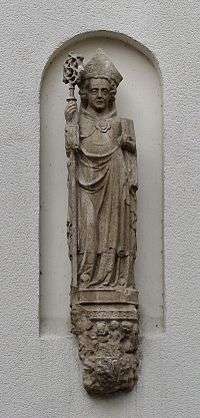Otto of Bamberg
| Saint Otto of Bamberg | |
|---|---|
 St. Otto of Bamberg | |
| Bishop and Confessor; Apostle of Pomerania | |
| Born |
1060 Mistelbach, Franconia |
| Died |
30 June 1139 Pomerania (now in modern-day Poland) |
| Venerated in | Roman Catholic Church |
| Canonized | 1189, Rome by Pope Clement III |
| Major shrine | St. Michael's Church, Bamberg, Bavaria, Germany |
| Feast | 2 July |

Saint Otto of Bamberg (German: Otto von Bamberg, Polish: Otton z Bambergu; 1060 or 1061 – 30 June 1139) was a medieval German bishop and missionary who, as papal legate, converted much of Pomerania to Christianity.
Life
Otto was born into a noble family in Mistelbach, Franconia. His elder brother inherited his father's property and Otto was sent to school.[1] Serving initially in the household of Duke Władysław I Herman of Poland, he entered the service of the Emperor Henry IV in 1090 and was appointed Chancellor of the Holy Roman Empire in 1101.[2]
In 1102, the Emperor appointed and invested him as Bishop of Bamberg in Franconia (now in the state of Bavaria), and Otto became one of the leading princes of medieval Germany. During his tenure as bishop, Bamberg rose to great prominence, while Otto achieved fame as a missionary and as a diplomat and politician, notably during the Investiture Controversy between Emperor Henry IV and the papacy during which he remained loyal to the emperor. As a consequence, he was suspended by a papal party at the Synod of Fritzlar in 1118. At the Congress of Würzburg in 1121 Otto successfully negotiated the peace treaty, the Concordat of Worms, which was signed in 1122 at Worms.[2]
As bishop, Otto led a model, simple and frugal life, but did much to improve his ecclesiastical and temporal realms. He restored and completed Bamberg Cathedral after it had been damaged by fire in 1081, improved the cathedral school, established numerous monasteries[2] and built a number of churches throughout his territory and in Pomerania, and greatly expanded the town of Bamberg, rebuilding the Monastery of St. Michael, which had been destroyed by an earthquake around 1117.[3]
Among his great accomplishments was his peaceful and successful missionary work among the Pomeranians, after several previous forcible attempts by Poles and Italians to convert Pomerania to Christianity had failed. Otto was sent on his mission by the Duke of Poland Bolesław III Wrymouth.[4] As the official papal legate, he converted a large number of Pomeranians, notably in the towns of Pyrzyce, Kamień, Szczecin, and Wolin, and established eleven churches, and became known as the "Apostle of Pomerania."
After he returned to Bamberg in 1125, some pagan customs began to reassert themselves, and Otto journeyed once more to Pomerania in 1128. In the Diet of Usedom, he succeeded in converting all the nobles, converted further communities, and sent priests from Bamberg to serve in Pomerania. His intent to consecrate a bishop for Pomerania was thwarted by the bishops of Magdeburg and Gniezno who claimed metropolitan rights over Pomerania. Only after his death in 1139 was his former companion, Adalbert of Pomerania, consecrated as Bishop of Wolin, in 1140.
It was Bishop Otto who clothed Saint Hildegard of Bingen as a Benedictine nun.[5]
Otto died on 30 June 1139, and was buried in Michaelsberg Abbey, Bamberg. He was canonised in 1189 by Pope Clement III. Although he died on 30 June, his name is recorded in the Roman martyrology on 2 July.
The area of western Prussia around Gdańsk was Christianized via Pomerania as well, and the monastery of Oliwa at Gdańsk was established at that time, while eastern Prussia was Christianized later via Riga by the Teutonic Knights.
See also
References
- ↑ Jaeger, C. Stephen. The Origins of Courtliness: Civilizing Trends and the Formation of Courtly Ideals, 939-1210, Chap.2, University of Pennsylvania Press, 1985
- 1 2 3 Löffler, Klemens. "St. Otto." The Catholic Encyclopedia. Vol. 11. New York: Robert Appleton Company, 1911. 28 Mar. 2013
- ↑ St. Michael's Monastery, Bamberg
- ↑ "St. Otto, Bishop". Catholic News Agency
- ↑ Benedict XVI, General Audience, 1 September 2010, Vatican News Service
- Charles Henry Robinson (editor), "The Life of Otto, Apostle of Pomerania, 1060-1139", New York: The Macmillan Company, 1920. Two contemporary biographies by Ebbo, d. 1163 and Herbordus, d. 1168 - from Internet Archive.
